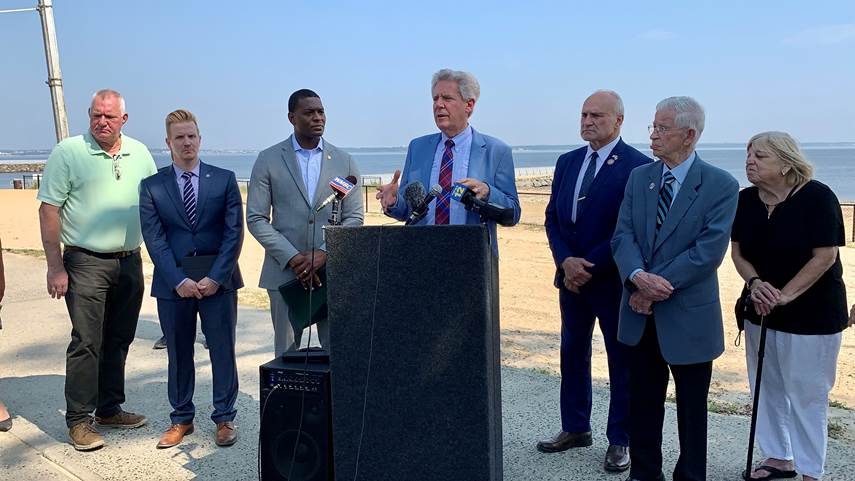By ALAN KARMIN
Correspondent
The U.S. Environmental Protection Agency (EPA) has taken over the cleanup of the Raritan Bay Slag Superfund Site along the Laurence Harbor Beach from NL Industries.
“NL industries has failed in their commitment to cleanup the site,” Congressman Frank Pallone, Jr. (D-6) said during a livestreamed press conference from Old Bridge Waterfront Park on Aug. 26, “and the EPA will now take over. However, the pollutant will pay us … the pollutant will be held accountable.”
The Raritan Bay Slag Superfund site is on the southern shore of Raritan Bay. The site consists of the Seawall Sector, which contains a seawall about 2,300 feet long in Old Bridge; the Margaret’s Creek Sector, which consists of a 47-acre wetland located immediately east of the Seawall Sector; and the Jetty Sector, which consists of the approximately 750-foot-long western jetty, located nearly a mile west of the seawall in adjacent Sayreville, according to information provided by the EPA.
On Jan. 30, 2014, the EPA directed NL Industries, formerly known as National Lead Industries, to conduct a $79 million cleanup at the site located in Old Bridge and Sayreville.
It was determined that soil and sediment had been contaminated with lead-containing waste that was used to construct a seawall and jetty along the beach of Laurence Harbor.
The Laurence Harbor seawall, which makes up a significant portion of the site, was reported to have had metal slag from blast furnace bottoms deposited – by National Lead Industries – along the beachfront in the late 1960s and early 1970s.
“This appears to be a common theme,” Pallone said. “These big corporations would often dump in communities that they just figured couldn’t complain about it. Most often they would do this in low income and minority communities where they just didn’t have the resources and figured ‘we’ll dump this stuff here and nobody will know the difference.’ ”
According to the EPA, approximately 2,500 feet of the seawall have been contaminated. Elevated levels of lead, antimony, arsenic and copper have been identified along the seawall near the area, courtesy of the former National Lead Industries.
NL Industries has not lived up to their obligations, according to a federal EPA official Walter Mugdan, acting regional administrator.
“We told them (NL Industries) back in February that we were dissatisfied with their progress, timeliness and quality of work. Nothing changed. So now we are taking over,” Mugdan said. “We are going to go with the original design from back in 2013, which is to completely remove the contaminated seawall and sand.”
The Raritan Bay Slag site was listed on the National Priorities List as far back as 2009. At the request of the New Jersey Department of Environmental Protection, EPA evaluated the site for a short term cleanup under the federal Superfund program.
“It’s been 12 years already. We want to turn the contaminated land into sustainable community assets,” Pallone said.
But how long will that take?
“It may be longer than you wish – but shorter than you fear,” Mugdan said.
Pallone has been a longtime advocate for cleanup of Superfund polluting sites in New Jersey. An estimated 50% of the state’s population lives within three miles of a Superfund site, according to information provided by his office.
As a result of Pallone’s advocacy, the Raritan Bay Slag site was placed on EPA’s Superfund National Priorities List in 2009. In October 2016, Pallone announced $7 million in funding from EPA to begin the cleanup at Margaret’s Creek, part of the Raritan Bay Slag Superfund site. The area had elevated levels of lead contamination, as well as areas of slag, a byproduct of metal smelting, and battery casings, according to the statement.
In April, Pallone re-introduced his Superfund Polluter Pays Act, which would ensure polluters pay for the cleanup of Superfund sites. The bill would accomplish this by reinstating the full extent of the Superfund taxes on corporate polluters that expired in 1995.

